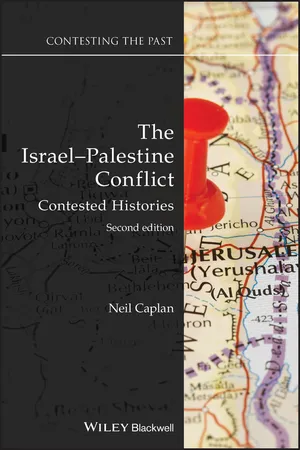
- English
- ePUB (mobile friendly)
- Available on iOS & Android
About this book
One of the "10 Must-Read Histories of the Palestine-Israel Conflict"
—Ian Black, Literary Hub, on the 100th anniversary of the Balfour Declaration
The new edition of the acclaimed text that explores the issues continuing to define the Israeli-Palestinian conflict
Numerous instances of competing, sometimes incompatible narratives of controversial events are found throughout history. Perhaps the starkest example of such contradictory representations is the decades-long conflict between Israel and Palestine. For over 140 years, Israelis, Palestinians, and scores of peacemakers have failed to establish a sustainable, mutually-acceptable solution. The Israel-Palestine Conflict introduces the historical basis of the dispute and explores both the tangible issues and intangible factors that have blocked a peaceful resolution. Author Neil Caplan helps readers understand the complexities and contradictions of the conflict and why the histories of Palestine and Israel are so fiercely contested.
Now in its second edition, this book has been thoroughly updated to reflect the events that have transpired since its original publication. Fresh insights consider the impact of current global and regional instability and violence on the prospects of peace and reconciliation. New discussions address recent debates over two-state versus one-state solutions, growing polarization in public discourse outside of the Middle East, the role of public intellectuals, and the growing trend of merging scholarship with advocacy. Part of the Wiley-Blackwell Contested Histories series, this clear and accessible volume:
- Offers a balanced, non-polemic approach to current academic discussions and political debates on the Israel-Palestine conflict
- Highlights eleven core arguments viewed by the author as unwinnable
- Encourages readers to go beyond simply assigning blame in the conflict
- Explores the major historiographical debates arising from the dispute
- Includes updated references and additional maps
Already a standard text for courses on the history and politics of the Middle East, The Israel-Palestine Conflict is an indispensable resource for students, scholars, and interested general readers.
Frequently asked questions
- Essential is ideal for learners and professionals who enjoy exploring a wide range of subjects. Access the Essential Library with 800,000+ trusted titles and best-sellers across business, personal growth, and the humanities. Includes unlimited reading time and Standard Read Aloud voice.
- Complete: Perfect for advanced learners and researchers needing full, unrestricted access. Unlock 1.4M+ books across hundreds of subjects, including academic and specialized titles. The Complete Plan also includes advanced features like Premium Read Aloud and Research Assistant.
Please note we cannot support devices running on iOS 13 and Android 7 or earlier. Learn more about using the app.
Information
Part I
Introduction
1
Problems in Defining the Conflict
What's in a Name?
Table of contents
- Cover
- Table of Contents
- List of Maps
- Preface to the First Edition
- Preface to the Second Edition
- Abbreviations
- Note on Sources
- Part I: Introduction
- Part II: Histories in Contention
- Part III: Towards a More Useful Discussion of the Arab–Israeli Conflict
- Chronology
- Bibliography
- Index
- End User License Agreement